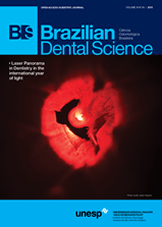Clinical and morphofunctional aspects of pterygoid hamulus: literature review
DOI:
https://doi.org/10.14295/bds.2015.v18i4.1078Abstract
The understanding on the pterygoid hamulus (PH) and its anatomical and functional relationship with neighboring structures is of utmost importance to conduct assertive, differential diagnosis and for the prevention of diseases in the region.This study aimed to review the literature on the anatomical and functional PH features, a bone structure sometimes neglected by the dentist. Also, the main pathologies occurring in HP are reported. PH relates with many anatomical elements of the cranium and face involved in a varied physiological processes such as speech and swallowing. The alteration of PH alterations and neighboring structures may cause symptoms similar to other craniofacial disorders hindering the correct diagnosis. PH may be involved in pathologies that should be included in the differential diagnosis from any craniofacial disorders.
Keywords
Pterygoid hamulus; Pterygoid hamulus syndrome; Bursitis pterygoid hamulus; Anatomy
Downloads
Downloads
Additional Files
Published
How to Cite
Issue
Section
License
Brazilian Dental Science uses the Creative Commons (CC-BY 4.0) license, thus preserving the integrity of articles in an open access environment. The journal allows the author to retain publishing rights without restrictions.
=================




























